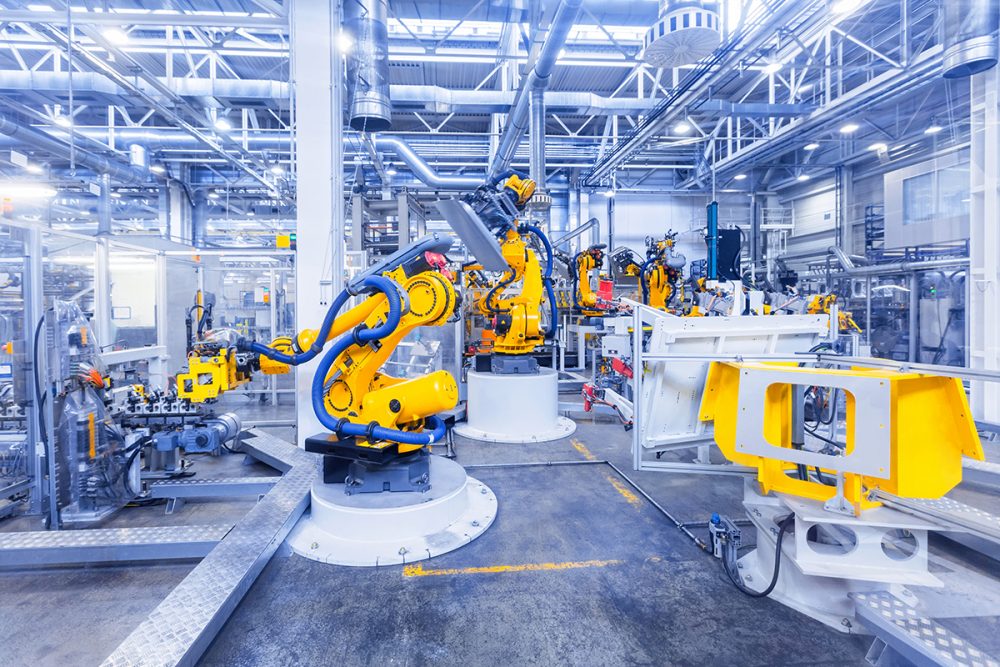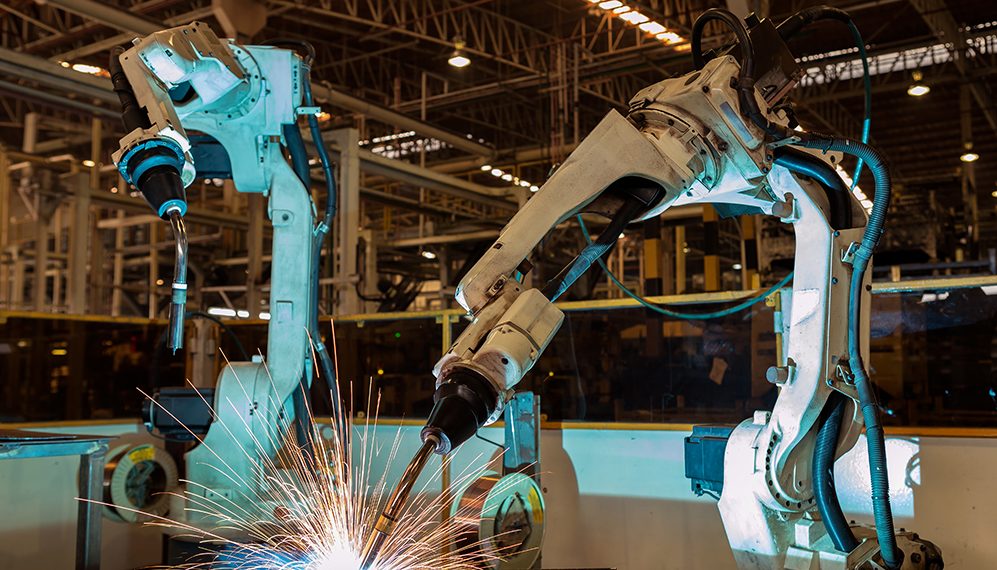
What is industrial automation?
Industrial automation is the set of methodologies (of automatic controls) and technologies (mechanical, electrical, electronic, information technology) that allow the automation of production processes in order to make the machines work
![]()
without or with reduced human intervention,
![]()
for operations that require precision, repeatability, speed and power impossible for a human operator,
![]()
for dangerous operations,
![]()
to meet constraints and regulations regarding safety and environmental impact.
Industrial automation controls production processes by offering:
- lower costs
- less wastage
- higher accuracy
- higher quality
- significant reduction in cycle time
- greater security
- high applicability
- greater efficiency and reliability
- continuity
The term automation was introduced in 1947 at Ford Motor Company as a contraction of “automatic production” to indicate the set of automatic handling equipment that had been installed in their production lines.
Automation includes all work processes and tools (machines, apparatus, tools and other devices) that allow the plants to operate autonomously and reduce human intervention to a minimum.
Industrial automation systems
GM Automations since 1989 designs and manufactures industrial automation systems for various production sectors offering its customers a complete and effective solution.
We start from the preliminary analysis, we study every single process, we design and test all the options to guarantee you the maximum result (programmable and measurable).
In our portfolio we can boast companies from various sectors for which we have carried out industrial automation projects regarding:


Robotic islands
(assembly, welding, deburring)
Robotic islands are sets of machines that include one or more industrial robots, which are automatically controlled and programmable in three or more axes. They find many and various industrial applications, from logistics to painting, assembly, welding, etc. The safety requirements for robotic islands are contained in the UNI EN ISO 10218-2 standard, which has been harmonized with respect to the Machinery Directive 2006/42/EC since 18 November 2011. Compliance with this standard therefore gives the presumption of conformity to the safety and health protection requirements covered by the standard itself.

Automatic warehouse
(automatic inter-operational transport and storage systems for industrial logistics)
Today, having an automatic warehouse (full or partial) is an interesting solution for many companies. Different phases of the production process (handling, picking, loading and unloading of goods) lend themselves to being automated, favoring a series of advantages:
– speed of operations,
– decrease in the risk of error,
– reduction of damage to the goods,
– reduction of travel, lifting and stowage times,
– integration of the warehouse with other business cycles such as goods traceability, stock control and inventory in real time.
Other obvious advantages are those for the benefit of the occupied space (which is usually much lower than that of a traditional warehouse) and the safety of the entire working process.

Handling lines
(generic robotized movement, compacting, carousel hanging, etc.)
Handling lines means the movement of loads, goods, packages, pallets or containers within a warehouse, logistics centre or factory, this can be done manually or by mechanical means. The concept of automatic handling refers to the automation of manual activities for moving loads and also implies the automation of processes without which it would be impossible to process goods flows more quickly and efficiently.
Among the most significant advantages are the improvement of operators’ work and the possibility of handling more orders in less time.
Picking is more accurate, improving preparation, grading and packaging.
Lead time and delivery times are improved, personnel costs are reduced.
It improves overall workplace safety including ergonomic aspects of picking, operators move less and the risk of injury is reduced. Automatic transport and handling systems can be integrated into assembly and production lines.

Packaging machines
(industrial packaging of food, drugs, cosmetics)
These are industrial machinery developed in recent years mainly in the food, pharmaceutical, cosmetic, etc. packaging sector. Thanks to the spread of the large distribution has grown the need to protect the various types of products and to increase, where possible / necessary, their durability.
Thermosealing machines
Thermosealing machines are packaging machines created to weld films in reels (polypropylene, polyester or other plastic films) on preformed plastic trays; the possibility to make vacuum inside the container and to introduce inert gases (protective atmosphere) makes this type of packaging machines the most used in food packaging.
Thermoforming machines
Thermoforming machines are packaging machines which, starting from two reels of film, first form the tray and then, after filling with the product, heat seal it. The thermoforming packaging machines give the possibility to introduce modified atmosphere into the package. These machines are suitable for medium-large productions because they reduce the costs for the lower part of the package (tray).
Blister machines
Blister machines are packaging machines to weld plastic valves on laminated cardboard.
The various classes of packaging machines differ mainly in the type and thickness of the materials used. Among others, we recall the Shrinkwrappers, the Bell shrinkwrappers and the Tunnel shrinkwrappers.

Automatic Palletizers
(Automatic machines for packaging products such as food, beverages and consumer goods packed on pallets)
Palletizer uses a mechanical arm to transport the goods from a flatbed to the pallet, all at a higher rate of work than by hand. It is usually connected to an automatic handling system (roller conveyor or belt), which allows the goods to be transported to the destination area. Through an interface, an operator sets the conditions under which the machine must carry out its work independently.Finally, at the end of most palletizing systems there is an automatic reel. Owning an automatic palletizer guarantees a lot of advantages:
Versatility
The use of different grippers to pick up and transport products allows the machine to be extremely versatile, making it highly customizable according to its needs.
Speed
The palletizing speed varies according to the products to be handled and its conformation with particular reference to the gripper, a machine, for example, can palletize 50 bags and up to 1200 cans per minute
Maintenance
In a robotic palletizer there are fewer mechanical components, which means that the reliability of the machine is really remarkable so it is easier to maintain.
Overall dimensions
The dimensions of the palletiser can vary according to the configuration of the packaging system but its extreme flexibility allows installation even in confined spaces while respecting the most up-to-date safety standards imposed by the market.
Reduction of accidents at work
If you consider the safety that robots offer compared to a person stacking the pallet by lifting the loads, the overall savings are even more significant. Palletizers help prevent workplace accidents caused by excessively heavy loads that affect the health of workers. However, they are not only limited to this function; they are also very useful, for example, if dangerous substances have to be packed in order to avoid human contact
Safer packaging
Thanks to the technology of these machines you will have safer and more stable packaging on pallets, ready to be shipped without further human control.
Quality packaging
Packaging resulting from the use of palletizers is of higher quality than human packaging, often clumsy and inaccurate.

Machine tools
(robotized machines dedicated to the machining of metallic and non-metallic materials by chip removal)
Machine tools are capable of transforming objects of any material, shape and size. This is done by removing over material, of various shapes, through the use of special tools. The latter are simply the mechanical tools used to perform a specific function.
In common use, the term “machine tool” is linked to the working of metals, wood or stone. Each tool, even if it characterizes the machine that uses it, does not constitute a real organ of the same. It is given a way to be supported, to have a certain relative motion to the processed material and to overcome resistance that it encounters during machining. The machine tools mainly have as field of application the manufacturing industry, the mechanical industry and above all the metal working.

Operating machines
In general, an operating machine is a generic apparatus capable of performing mechanical and non-mechanical operations automatically, or with the assistance of a human being. It exploits the work given from outside the system for its operation.



